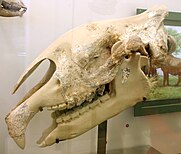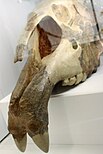Paraceratherium
| Paraceratherium | |
|---|---|
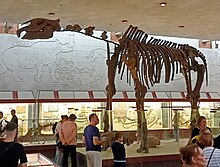
| |
| Mounted P. transouralicum skeleton, Moscow Paleontological Museum; this is the most completely known skeleton, but the skull is a cast of a specimen at American Museum of Natural History[1] | |
| Scientific classification | |
| Domain: | Eukaryota |
| Kingdom: | Animalia |
| Phylum: | Chordata |
| Class: | Mammalia |
| Order: | Perissodactyla |
| Family: | †Paraceratheriidae |
| Genus: | †Paraceratherium Forster-Cooper, 1911 |
| Type species | |
| †Aceratherium bugtiense Pilgrim, 1908
| |
| Species | |
| |
| Synonyms | |
|
Genus synonymy
Species synonymy
| |
Paraceratherium is an extinct genus of hornless rhinocerotoids belonging to the family Paraceratheriidae. It is one of the largest terrestrial mammals that has ever existed and lived from the early to late Oligocene epoch (34–23 million years ago). The first fossils were discovered in what is now Pakistan, and remains have been found across Eurasia between China and the Balkans. Paraceratherium means "near the hornless beast", in reference to Aceratherium, the genus in which the type species P. bugtiense was originally placed.
The exact size of Paraceratherium is unknown because of the incompleteness of the
The
Taxonomy
The
Early discoveries of
In 1910, more partial fossils were discovered in Dera Bugti during an expedition by the British palaeontologist
A

In 1922, the American explorer Roy Chapman Andrews led a well-documented expedition to China and Mongolia sponsored by the American Museum of Natural History. Various indricothere remains were found in formations of the Mongolian Gobi Desert, including the legs of a specimen standing in an upright position, indicating that it had died while trapped in quicksand, as well as a very complete skull. These remains became the basis of Baluchitherium grangeri, named by Osborn in 1923.[14][15]
In 2017, a new species, P. huangheense, was named by the Chinese palaeontologist Yong-Xiang Li and colleagues based on jaw elements from the Hanjiajing Formation in the
Species and synonyms

In 1922 Forster-Cooper named the new species
In 1989, the American palaeontologists
According to Lucas and Sobus, the type species P. bugtiense from the late Oligocene of Pakistan included junior synonyms such as B. osborni and P. zhajremensis. P. transouralicum from the late Oligocene of Kazakhstan, Mongolia, and northern China included B. grangeri and I. minus. By this scheme, P. orgosensis from the middle and late Oligocene of northwest China included D. turfanensis and P. lipidus.[22] In 2013, the American palaeontologist Donald Prothero suggested that P. orgosensis may be distinct enough to warrant its original genus name Dzungariotherium, though its exact position requires evaluation. P. prohorovi from the late Oligocene of Kazakhstan may be too incomplete for its position to be resolved in relation to the other species; the same applies to proposed species such as I. intermedium and P. tienshanensis, as well as the genus Benaratherium.[3][22] Though the genus name Indricotherium is now a junior synonym of Paraceratherium, the subfamily name Indricotheriinae is still in use because genus name synonymy does not affect the names of higher level taxa that are derived from these. Members of the subfamily are therefore still commonly referred to as indricotheres.[24]
In contrast to the revision by Lucas and Sobus, a 2003 paper by Chinese palaeontologist Jie Ye and colleagues suggested that Indricotherium and Dzungariotherium were valid genera, and that P. prohorovi did not belong in Paraceratherium. They also recognised the validity of species such as P. lipidus, P. tienshanensis, and P. sui.[25] A 2004 paper by Deng and colleagues also recognised three distinct genera.[26] Some western writers have similarly used names otherwise considered invalid since the 1989 revision, but without providing detailed analysis and justification.[3] Deng and colleagues recognised six Paraceratherium species in 2021, including some that had previously been declared synonyms, P. grangeri, P. asiaticum, and P. lepidum, while keeping Indricotherium and Baluchitherium as synonyms of the genus.[17][3]
Evolution
The
The subfamily Indricotheriinae, to which Paraceratherium belongs, was first classified as part of the family Hyracodontidae by the American palaeontologist
The cladogram below follows the 1989 analysis of Indricotheriinae by Lucas and Sobus, and shows the closest relatives of Paraceratherium:[22]
| Hyracodontidae |
| ||||||||||||||||||||||||
Lucas and colleagues had reached similar conclusions in a previous 1981 analysis of Forstercooperia, wherein they still retained Paraceratherium and Indricotherium as separate genera.[31] In 2016, the Chinese researchers Haibing Wang and colleagues used the name Paraceratheriidae for the family and Paraceratheriine for the subfamily, and placed them outside of Hyracodontidae.[32] Deng and colleagues confirmed previous studies with their 2021 analysis, suggesting that Juxia evolved from a clade consisting of Forstercooperia and Pappaceras 40 million years ago, with the resulting stock evolving into Urtinotherium in the late Eocene and Paraceratherium in the Oligocene. These researchers did not find Hyracodontidae to form a natural group, and found Paraceratheriidae to be closer to Rhinocerotidae, unlike previous studies.[17]
Description

Paraceratherium is one of the largest known land mammals that have ever existed, but its precise size is unclear because of the lack of complete specimens.[4] Its total body length was estimated as 8.7 m (28.5 ft) from front to back by Granger and Gregory in 1936, and 7.4 m (24.3 ft) by the palaeontologist Vera Gromova in 1959,[33] but the former estimate is now considered exaggerated. The weight of Paraceratherium was similar to that of some extinct proboscideans, with the largest complete skeleton known belonging to the steppe mammoth (Mammuthus trogontherii).[34][35] Despite its roughly equivalent mass, Paraceratherium might have been taller than any proboscidean.[4] Its shoulder height was estimated as 5.25 m (17.2 ft) at the shoulders by Granger and Gregory, but 4.8 m (15.7 ft) by the palaeontologist Gregory S. Paul in 1997.[36] The neck was estimated at 2 to 2.5 m (6.6 to 8.2 ft) long by the palaeontologists Michael P. Taylor and Mathew J. Wedel in 2013.[37]
Early estimates of 30 tonnes (66,000 lb) are now considered exaggerated; it may have been in the range of 15 to 20 tonnes (33,000 to 44,000 lb) at maximum, and as low as 11 tonnes (24,000 lb) on average. Calculations have mainly been based on fossils of P. transouralicum because this species is known from the most complete remains.[4] Estimates have been based on skull, teeth, and limb bone measurements, but the known bone elements are represented by individuals of different sizes, so all skeletal reconstructions are composite extrapolations, resulting in several weight ranges.[34][38]
There are no indications of the colour and skin texture of the animal because no skin impressions or mummies are known. Most life restorations show the creature's skin as thick, folded, grey, and hairless, based on modern rhinoceroses. Because hair retains body heat, modern large mammals such as elephants and rhinoceroses are largely hairless. Prothero has proposed that, contrary to most depictions, Paraceratherium had large elephant-like ears that it used for thermoregulation. The ears of elephants enlarge the body's surface area and are filled with blood vessels, making the dissipation of excess heat easier. According to Prothero, this would have been true for Paraceratherium, as indicated by the robust bones around the ear openings.[4] The palaeontologists Pierre-Olivier Antoine and Darren Naish have expressed scepticism towards this idea.[39][40]
Due to the fragmentary nature of known Paraceratherium fossils, the skeleton of the animal has been reconstructed in several different ways since its discovery.[41] In 1923, Matthew supervised an artist to draw a reconstruction of the skeleton based on the even less complete P. transouralicum specimens known by then, using the proportions of a modern rhinoceros as a guide.[42] The result was too squat and compact, and Osborn had a more slender version drawn later the same year. Some later life restorations have made the animal too slender, with little regard to the underlying skeleton.[4] Gromova published a more complete skeletal reconstruction in 1959, based on the P. transouralicum skeleton from the Aral Formation, but this also lacked several neck vertebrae.[33]
Skull
The largest skulls of Paraceratherium are around 1.3 metres (4.3 ft) long, 33 to 38 centimetres (13 to 15 in) at the back of the skull, and 61 centimetres (24 in) wide across by the
The back of the skull was low and narrow, without the large
The species of Paraceratherium are mainly discernible through skull characteristics. P. bugtiense had features such as relatively slender
Unlike those of most primitive rhinocerotoids, the front teeth of Paraceratherium were reduced to a single pair of incisors in either jaw, which were large and conical, and have been described as tusks. The upper incisors pointed downwards; the lower ones were shorter and pointed forwards. Among known rhinoceroses, this arrangement is unique to Paraceratherium and the related Urtinotherium. The incisors may have been larger in males. The canine teeth otherwise found behind the incisors were lost. The incisors were separated from the row of cheek teeth by a large diastema (gap).[4] This feature is found in mammals where the incisors and cheek teeth have different specialisations.[27] The upper molars, except for the third upper molar that was V-shaped, had a pi-shaped (π) pattern and a reduced metastyle. The premolars only partially formed the pi pattern. Each molar was the size of a human fist; among mammals they were only exceeded in size by proboscideans, though they were small relative to the size of the skull. The lower cheek teeth were L-shaped, which is typical of rhinoceroses.[4]
Postcranial skeleton

No complete set of
The limbs were large and robust to support the animal's large weight, and were in some ways similar to and
Palaeobiology
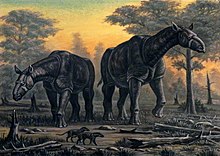
The zoologist
Most terrestrial predators in their habitat were no bigger than a modern
Diet and feeding
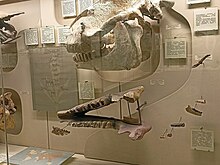
The simple, low-crowned teeth indicate that Paraceratherium was a browser with a diet consisting of relatively soft leaves and shrubs. Later rhinoceroses were grazers, with high-crowned teeth because their diets contained grit that quickly wore down their teeth. Studies of
Granger and Gregory argued that the large incisors were used for defence or for loosening shrubs by moving the neck downwards, thereby acting as picks and levers.[20] Tapirs use their proboscis to wrap around branches while stripping off bark with the front teeth; this ability would have been helpful to Paraceratherium. Some Russian authors suggested that the tusks were probably used for breaking twigs, stripping bark and bending high branches and that, because species from the early Oligocene had larger tusks than later ones, they probably had a more bark than leaf based diet. Since the species involved are now known to have been contemporaneous, and the differences in tusks are now thought to be sexually dimorphic, the latter idea is not accepted today.[4] Herds of Paraceratherium may have migrated while continuously foraging from tall trees, which smaller mammals could not reach.[30] Osborn suggested that its mode of foraging would have been similar to that of the high-browsing giraffe and okapi, rather than to modern rhinoceroses, whose heads are carried close to the ground.[42]
Distribution and habitat

Remains assignable to Paraceratherium have been found in early to late Oligocene (34–23 million years ago) formations across Eurasia, in modern-day China, Mongolia, India, Pakistan, Kazakhstan, Georgia, Turkey, Romania, Bulgaria, and the
The habitat of Paraceratherium appears to have varied across its range, based on the types of geological formations it has been found in.

Deng and colleagues speculated about the
Extinction

The reasons Paraceratherium and its relatives became extinct after surviving for about 11 million years are unknown, but it is unlikely that there was a single cause. Theories include that their large size was related to the now outdated concept of
Putshkov and Andrzej H. Kulczicki instead suggested in 1995 and 2001 that invading
References
- ^ a b c d e Prothero, 2013. pp. 17–34
- ^ S2CID 207150574.
- ^ a b c d e f g h Prothero, 2013. pp. 67–86
- ^ a b c d e f g h i j k l m n o p q r Prothero, 2013. pp. 87–106
- ^ a b c Prothero, 2013. pp. 35–52
- ^ Pilgrim, G. E. (1910). "Notices of new mammalian genera and species from the Tertiaries of India". Records of the Geological Survey of India. 40 (1): 63–71.
- ^ .
- ^ from the original on 20 November 2015. Retrieved 28 August 2015.
- from the original on 7 October 2015. Retrieved 28 August 2015.
- from the original on 12 August 2018. Retrieved 13 January 2018.
- JSTOR 92060.
- ^ Pavlova, M. (1922). "Indricotherium transouralicum n. sp. provenant du district de Tourgay". Bulletin de la Société des Naturalistes de Moscou, Section Géologique (in French). 31: 95–116.
- ^ Borissiak, A. A. (1924). "Über die Unterfamilie Indricotheriinae Boriss. = Baluchitheriinae Osb". Zentralblatt für Mineralogie, Geologie und Paläontologie (in German). 18: 571–575.
- ^ Prothero, 2013. pp. 1–16
- ^ Osborn, H. F. (1923). "The extinct giant rhinoceros Baluchitherium of Western and Central Asia". Natural History. 3. 23: 208–228. Archived from the original on 9 March 2016. Retrieved 8 September 2014.
- ^ from the original on 12 October 2017. Retrieved 11 October 2017.
- ^ PMID 34140631.
- .
- PMID 29668673.
- ^ hdl:2246/363.
- .
- ^ OCLC 19268080
- ^ Zhan-Xiang, Q. (1973). "A new genus of giant rhinoceros from oligocene of Dzungaria, Sinkang" (PDF). Vertebrata PalAsiatica. 11 (in Chinese and English). 2: 182–191. Archived (PDF) from the original on 22 October 2014. Retrieved 22 October 2014.
- .
- ^ Ye, Y.; J., Meng; Yu, W. W. (2003). "Discovery of Paraceratherium in the northern Junggar Basin of Xinjiang" (PDF). Vertebrata PalAsiatica (in Chinese and English). 41: 220–229. Archived (PDF) from the original on 3 March 2016. Retrieved 22 October 2014.
- ^ Qui, Z.-X.; Wang, B.-Y.; Deng, T. (2004). "Indricotheres (Perissodactyla, Mammalia) from Oligocene in Linxia Basin, Gansu, China" (PDF). Vertebrata PalAsiatica (in Chinese and English). 42 (3): 177–192. Archived from the original (PDF) on 22 October 2014. Retrieved 22 October 2014.
- ^ a b c d Prothero, 2013. pp. 53–66
- JSTOR 1377893.
- PMID 34902952.
- ^ a b c d e f g h i Prothero, 2013. pp. 107–121
- JSTOR 1304430.
- PMID 28000789.
- ^ a b Gromova, V. L. (1959). "Gigantskie nosorogi". Trudy Paleontology Institut Akademii Nauk SSSR (in Russian). 71: 154–156.
- ^ .
- (PDF) from the original on 24 August 2016.
- ^ Paul, G. S. (1997). "Dinosaur models: The good, the bad, and using them to estimate the mass of dinosaurs" (PDF). Dinofest International Proceedings: 129–142. Archived (PDF) from the original on 4 March 2016. Retrieved 3 January 2015.
- PMID 23638372.
- S2CID 54686160.
- from the original on 12 November 2014. Retrieved 20 October 2014.
- ^ Naish, D. (29 June 2013). "Tet Zoo Bookshelf: van Grouw's Unfeathered Bird, Bodio's Eternity of Eagles, Witton's Pterosaurs, Van Duzer's Sea Monsters on Medieval and Renaissance Maps!". blogs.scientificamerican.com/tetrapod-zoology. Archived from the original on 6 October 2014. Retrieved 5 October 2014.
- hdl:2246/2123.
- ^ hdl:2246/3262.
- PMID 21251189.
- .
- ^ Alexander, R. M. (1998). "All-time giants: the largest animals and their problems". Palaeontology. 41 (6): 1231–1245. Archived from the original on 27 September 2016. Retrieved 1 March 2016.
- (PDF) from the original on 8 June 2019. Retrieved 6 August 2018.
- ^ .
- .
- S2CID 19968371.
- S2CID 204998953.
- ISBN 978-0-691-02542-1
- ^ a b Putshkov, P. V. (2001). ""Proboscidean agent" of some Tertiary megafaunal extinctions". Terra Degli Elefanti Congresso Internazionale: The World of Elephants: 133–136.
Bibliography
- Prothero, D. (2013). Rhinoceros Giants: The Palaeobiology of Indricotheres. Indiana: Indiana University Press. ISBN 978-0-253-00819-0.





